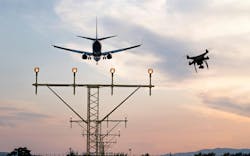FAA approaches industry for enabling technologies to integrate uncrewed aircraft into controlled airspace
Questions and answers:
- What is the main goal of the FAA's recent announcement regarding uncrewed aircraft systems (UAS)? To develop new technologies that help safely and efficiently integrate uncrewed aircraft into controlled U.S. airspace.
- What are some of the key focus areas in the FAA’s UAS integration project? Traffic management, beyond-visual-line-of-sight operations, detect-and-avoid technologies, command and control links, autonomous operations, and noise/environmental impacts.
- How can companies participate in the FAA’s UAS integration initiative? Interested companies must submit 10-page white papers by 30 Sept. 2028, and may be invited to submit full proposals if selected.
WASHINGTON – U.S. government aviation officials are reaching out to industry to develop new enabling technologies to help blend uncrewed aircraft safely and efficiently into controlled U.S. airspace.
Officials of the Federal Aviation Administration (FAA) in Washington issued a broad agency announcement (697DCK-25-R-00278) on Tuesday for technologies related integrating uncrewed aircraft systems (UAS) into the national airspace system (NAS).
This project has 10 focus areas: UAS traffic management; beyond-visual-line-of-sight (BVLOS) operations; UAS integration industry consensus standards; electronic conspicuity (EC); noise and environmental impacts; command and control (C2) link technologies; detect and avoid (DAA) technologies; UAS collision safety; autonomous operations; and advanced air mobility (AAM).
UAS traffic management seeks to integrate uncrewed air traffic control into controlled U.S. airspace that will provide services equivalent to those available for crewed aircraft.
Beyond line of sight
Beyond-visual-line-of-sight operations seeks to enable uncrewed aircraft operators to operate easily beyond the UAS's line of sight using performance-based standards for safe uncrewed beyond-line-of-sight operations.
UAS integration industry consensus standards involves aircraft to anything; safety and certification; beyond line of sight; command and control; detect-and-avoid; electronic conspicuity; UAS traffic management, and counter-UAS.
Electronic conspicuity seeks to enable crewed and uncrewed aircraft to operate safely and efficiently in the same airspace, with new technologies to enable detect and avoid, and to report the position of low-flying aircraft that do not have Automatic Dependent Surveillance–Broadcast (ADS-B) avionics.
Noise and environmental impacts seeks to mitigate the effects of uncrewed aircraft noise, and to keep abreast of how new and emerging aviation noise standards may influence uncrewed aircraft design and deployment.
Tell me more about integrating uncrewed aircraft into controlled airspace ...
- Integrating uncrewed aircraft into controlled airspace involves air traffic control (ATC) services to ensure the safe and efficient movement of aircraft operating around airports, high-density routes, and other areas with significant air traffic. The main challenge is ensuring that uncrewed aircraft can coexist with crewed aircraft --particularly in busy areas. This involves automated detect-and-avoid technologies; communication with air traffic control; uncrewed traffic management; and accepted safety and standards. It requires failsafe mechanisms to ensure the uncrewed aircraft can return home or land safely if communication with the operator is lost, as well as remote identification to make sure that uncrewed aircraft can be tracked by air traffic controllers.
Command and control link technologies seeks to uncrewed aircraft remote operators with reliable links to and from air traffic controllers to transmit and receive data like system health or identification of any collision threats.
Command and control links could include control non-payload communication; links over C-Band, L-Band, satellites, and cell phone systems in a move towards performance-based standards.
Detect-and-avoid technologies provides for collision avoidance among crewed aircraft, uncrewed aircraft, terrain, and other obstacles in controlled airspace.
UAS collision safety seeks to avoid collisions and near collisions involving uncrewed aircraft of various sizes, traveling at various speeds.
Autonomous operations
Autonomous operations seeks to enable uncrewed aircraft operations with minimal or no human intervention, and instead rely on advanced automation, artificial intelligence (AI), and other advanced technologies to manage tasks and make decisions. FAA experts particularly are interested in systems that can learn, adapt, and optimize operations in real-time in complex environments.
Advanced air mobility focuses on integrating fixed-wing automated aircraft and helicopters into controlled airspace, with a goal of efficient, safe, and sustainable ways to move people and goods.
Companies interested should email 10-page white papers no late than 30 Sept. 2028 to the FAA's Scott Raber at [email protected] and Kristin Frantz at [email protected]. The FAA has $6 million for each for 2025 through 2028 for these projects.
Companies submitting promising white papers may be invited to submit full proposals. Email questions or concerns to the FAA's Scott Raber at [email protected] and Kristin Frantz at [email protected]. More information is online at https://sam.gov/workspace/contract/opp/b21f5b8f19d74a479b1ce8befa69ad54/view.
About the Author
John Keller
Editor-in-Chief
John Keller is the Editor-in-Chief, Military & Aerospace Electronics Magazine--provides extensive coverage and analysis of enabling electronics and optoelectronic technologies in military, space and commercial aviation applications. John has been a member of the Military & Aerospace Electronics staff since 1989 and chief editor since 1995.
